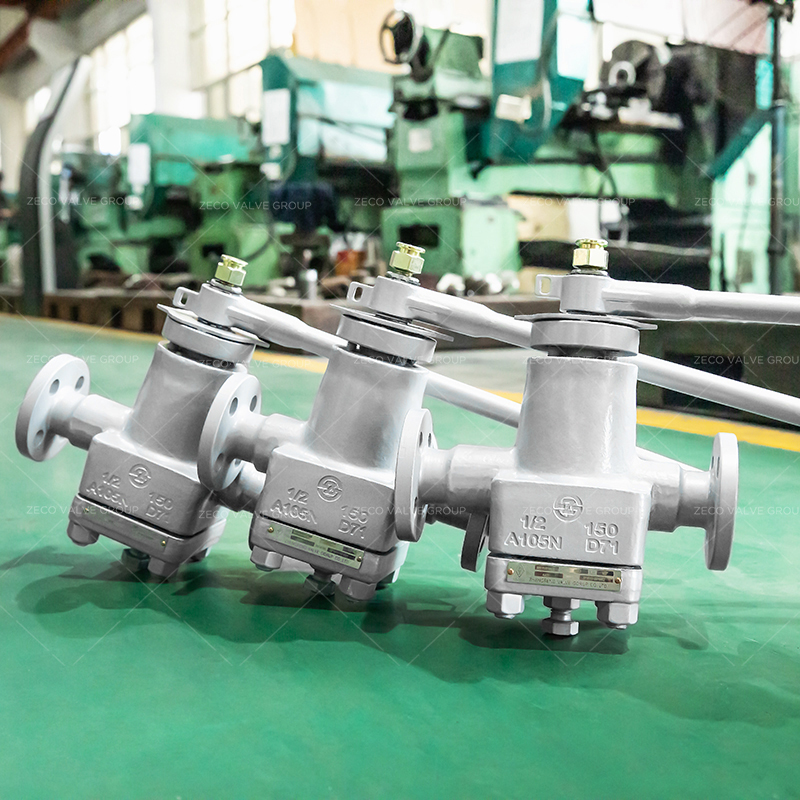A plug valve is a quarter-turn rotary motion manual valve. It uses a cylindrical or tapered plug (plug-shaped disk) to permit or prevent straight-through flow through the body. Plug valves offer a straightway passage through the ports so that fluid can flow through the opening plug with a minimum of turbulence. Flow can be in either direction fully open or fully closed.
Plug valves are available in various types as given below:
Lubricated Plug Valve
The lubrication plug valve uses lubricant to reduce frictions and make each port tightly sealed. Lubricants are basically base oils that increase the viscosity of moving parts, such as amorphous or fumed silica, which is injected between the valve plug surface and the valve body seat under high pressure.
The manufacturer suggests using a lubricant that matches the process fluid and resealing the valve after a certain number of cycles (or after each cycle in some applications.
Because of this maintenance requirement, lubrication valves are used in non-continuous operation applications. This type of valve is suitable for processes where light abrasive particles are suspended in the fluid, such as upstream applications, gas pipelines that require bypass valves, and purge valves as valve stations and kick valves.
This type of plug device generally has a metal valve seat.

Non-Lubricating Type Plug Valve
This plug valve utilizes a tapered or cone shape that acts as a wedge and presses a polymeric sleeve against the body cavity. The use of the sleeve reduces friction between the plug mechanism and the body.
Non-lubricated plug valves are often used instead of lubricated ones in applications where maintenance needs to be kept to a minimum, such as special services in Sulphur, hydrogen fluoride, or where liquids could be trapped or solidify and potentially jam the valve.
However, non-lubricated plug valves are limited by the temperature and chemical compatibility of the non-metallic materials they are made of.
The three main types of non-lubricated valves are: fully lined, elastomer sleeves, and lift plug valves.
Eccentric Type Plug Valve
The design of the eccentric valve has the characteristics of a half plug, which is a key advantage for applications that require stronger seat force and minimal friction from open to closed positions.
Compared with the concentric design, the closing capacity of the eccentric valve is also improved.
Typical applications of this type of china gas cock plug valve are dirty water, sewage, sludge and mud, air, and other similar services that require strict closure.
Double Expansion Type (Double Valve Block and Bleed – DBB)
This is the most complicated plug valve design because it is characterized by multiple components, which make the valve mechanically expand so that it has a true double blocking and deflation function.
In applications that do not require double isolation, they are often used to prevent product contamination.
The expansion valve uses a mechanism that rotates between open and closed positions and protects the two seals from the flow path. During the rotation, the valve body and the sealing ring are not in contact. When the valve is closed, the slider will expand to the valve body seat to prevent wear or abrasion of the sealing ring.
Soft-Sealed, Fire-safe Plug Valve
Fire safety plug valves use a narrow-band primary sealing ring made of a flexible, elastic material (such as Teflon) in the ring between the plug and the body cavity to prevent leakage.
A fire-safe soft seal valve also has a secondary metal-to-metal backup seal. This ensures a positive closing capability if the soft seal is damaged by fire. The maximum temperature limit of the valve is limited by the soft-seal material.
Applications of Plug Valve
As indicated earlier, the plug valves can be and have been used in many different fluid services. They perform well in slurry applications. They are primarily used in bubble-tight services as on-off stop valves. The wiping-off action of a plug does not permit suspended particles to accumulate and form crud. The following are some typical applications of plug valves:
- Air, gaseous, and vapor services
- Natural gas piping systems
- Coal slurries, mineral ores, mud, and sewage applications
- Oil piping systems
- Vacuum to high-pressure applications
Related Tags :
Ten articles before and after
Freeze Protection And Maintenance Of Valves In Winter
Difference Between Ball Valve and Butterfly Valve – Zeco Valve
Top 5 Butterfly Valve Manufacturers in the USA – Zeco Valve
Introduction of V-type Ball Valves
Valve Corrosion Prevention and Treatment












